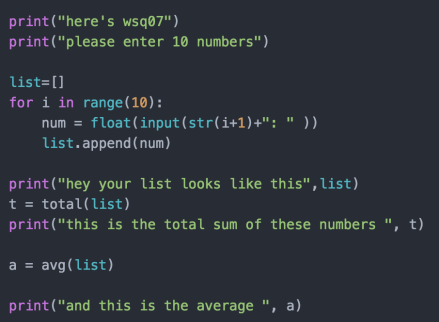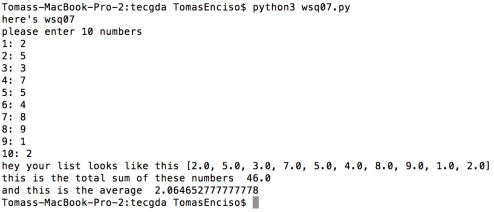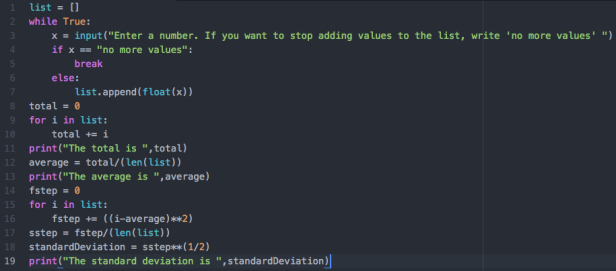--Originally published at Tomas Enciso
This program lets the user create a list of 10 numbers, then it shows you that list and gives you the sum of these numbers and the average between those 10 numbers.


Introduction to Programming with Python
--Originally published at Tomas Enciso
This program lets the user create a list of 10 numbers, then it shows you that list and gives you the sum of these numbers and the average between those 10 numbers.


--Originally published at マルコ
Create a program that asks the user for 10 numbers (floating point). Store those numbers in a list. Show to the user the total, average and standard deviation of those numbers.
For the Python group, you want to be using Lists. For the C++ group you can do this with arrays or Vectors, but you will need to know eventually how to do both.
Once you have this working, change it so that users keep giving you values until they signal “no more values”. How would you implement this and in particular for the C++ group, how to you deal with an unknown size to your array during compilation?


Featured image:
http://www.pixiv.net/member_illust.php?mode=medium&illust_id=14071780
--Originally published at Héctor Santillán
En esta ocasión se debe desarrollar un programa que tome diez números y entregue la suma de ellos, su promedio y su desviación estándar.
Se empieza por importar statistics, con el cual tendremos acceso a las operaciones de promedio y desviación estándar. Luego de pedir los números, los incluimos en una lista y finalmente realizamos las operaciones con statistics.mean() y statistics.stdev().
Para desarrollar este programa me apoyé en conocimientos previos y una breve investigación del módulo statistics.
--Originally published at Elu's Blog
For this assignment theses were my instructions:
Create a program that asks the user for 10 numbers (floating point). Store those numbers in a list. Show to the user the total, average and standard deviation of those numbers.
Once you have this working, change it so that users keep giving you values until they signal “no more values”.
This is what I came up with:


--Originally published at Python learning
Another program I made was one that would ask the user to introduce 10 numbers, then it would store those numbers in a list and output the total, average, and standard deviation of them.
First things first, I learned about lists in python from this page:
https://www.tutorialspoint.com/python/python_lists.htm
Also, I didn’t actually know the formula for standard deviation, so I looked it up and found these useful pages:
https://www.mathsisfun.com/data/standard-deviation-formulas.html
http://www.gmatfree.com/module-999/gmat-standard-deviation/
Finally, this other page helped me by giving me an idea of how to do it:
http://stackoverflow.com/questions/15389768/standard-deviation-of-a-list
At the end, my program looked like this:

And worked like this:
